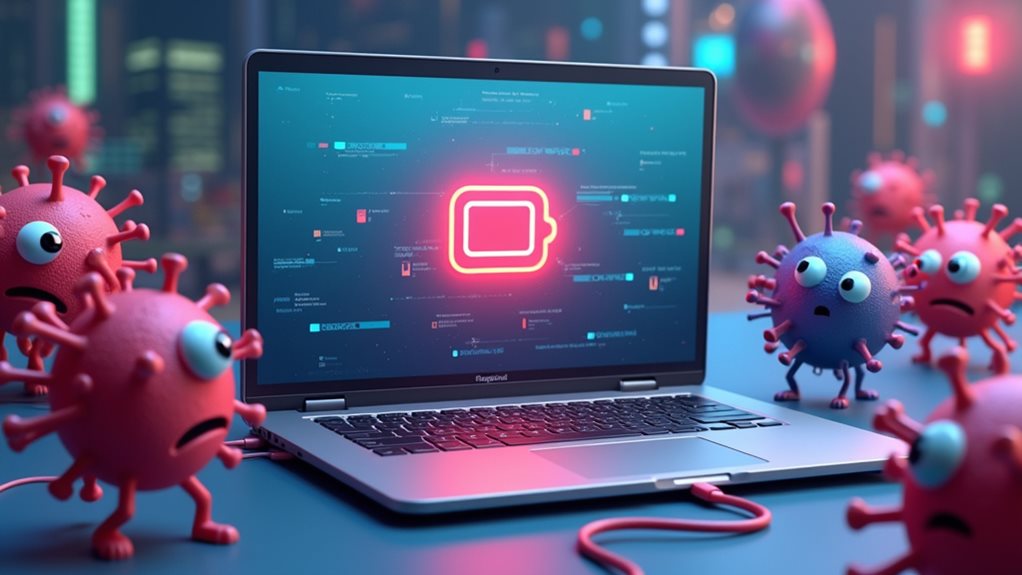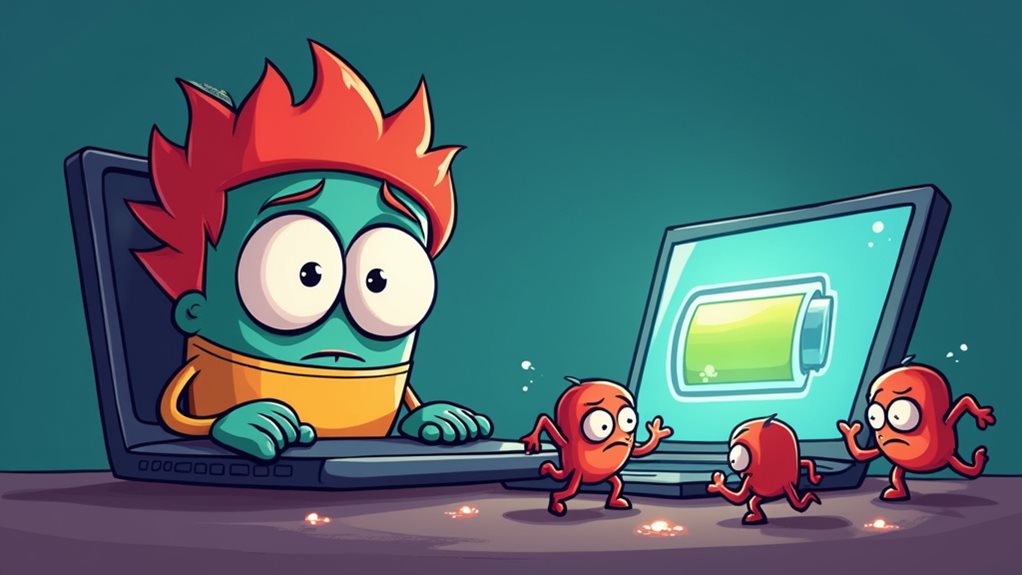Signs of a Virus: Rapid Battery Drain on Laptops
Rapid battery drain serves as a significant indicator of virus infection on laptops. Malicious programs operate multiple hidden processes that consume excessive CPU power, RAM, and disk activity, leading to accelerated battery depletion. Common signs include unexpected system crashes, overheating issues, and unauthorised background processes visible in Task Manager. Users should monitor for suspicious resource consumption patterns and disabled antivirus software. Understanding these warning signs allows for prompt detection and removal of battery-draining malware.
Understanding the Connection Between Viruses and Battery Life

When a virus infects a laptop, one of its most noticeable effects can be a significant decrease in battery life.
Virus behaviour typically involves running multiple hidden processes concurrently, severely disrupting normal resource management. These malicious programs consume excessive CPU power, RAM, and disk activity during operation in the background. Running multiple unknown background processes can significantly impact system performance and battery life.
The increased system load forces hardware components to work harder, resulting in accelerated battery drain. Furthermore, viruses may engage in unauthorised network activities, such as data mining or spam distribution, further depleting the battery through continuous connectivity demands and system resource exploitation. Checking your sent email folder for messages you didn't send can help identify if a virus is behind your battery issues. Regular system crashes and frequent freezing issues often accompany this excessive battery consumption. Using real-time protection from reputable antivirus software can help detect and prevent malware before it impacts your battery life.
Key Warning Signs Your Laptop Has a Battery-Draining Virus

Detecting a battery-draining virus on a laptop requires users to remain vigilant for several telltale warning signs.
Common virus symptoms include unusually rapid battery depletion accompanied by high CPU usage, even when running minimal applications.
Effective malware detection involves monitoring system behaviour for unexpected crashes, overheating, and unauthorised background processes.
Monitor your system closely for crashes, high temperatures and suspicious processes to effectively identify malware infections.
Users may notice significant performance degradation alongside battery issues, with Task Manager revealing suspicious resource consumption patterns.
Multiple security disruptions, such as disabled antivirus software or unauthorised browser modifications, often indicate the presence of battery-draining malware compromising system efficiency.
How to Check and Remove Battery-Draining Malware

Successfully removing battery-draining malware requires users to follow a systematic approach of detection and elimination. The process begins with effective malware detection through system monitoring tools like Task Manager or Activity Monitor to identify suspicious resource consumption. Suspicious pop-ups and rapid battery drain often indicate hidden malware running in the background.
Users should then disconnect from the internet and boot into Safe Mode before running thorough antivirus scans. Resource monitoring helps track CPU, RAM, and GPU usage patterns that indicate malware presence.
After removing detected threats, users should implement preventive measures, including regular security updates, robust antivirus software, and safe browsing practices to prevent future infections.
Best Practices to Protect Your Laptop's Battery Health

Protecting a laptop's battery health requires implementing thorough maintenance strategies and adopting proper usage habits.
Effective battery maintenance includes keeping charge levels between 20% and 80%, avoiding complete discharge, and storing devices with a 50% charge during extended periods of non-use.
Maintaining laptop battery charges between 20-80% and storing at 50% helps maximize longevity and prevent premature capacity loss.
Software optimisation plays a vital role through proper power settings configuration, enabling battery-saving modes, and closing unnecessary background processes. Using BatteryCare or PowerShell helps monitor detailed battery performance metrics over time.
Regular diagnostic checks help monitor battery health, while maintaining cool operating temperatures and proper storage conditions prevent premature degradation.
Users should likewise inspect batteries periodically for physical damage and verify that charging equipment remains in good condition.
Plugging charger first into the laptop before connecting to the wall outlet helps prevent potentially damaging power surges.
Regular calibration can help maintain accuracy by following the full charge-discharge cycle process to reset the battery's power indicators.
Running malware scans regularly can prevent malicious programs from draining battery life and causing system performance issues.
Frequently Asked Questions
Can a Virus Permanently Damage My Laptop's Battery Capacity?
Although viruses cannot directly alter battery capacity, certain types of viruses can indirectly affect battery health through excessive resource consumption, leading to increased charging cycles and heat generation.
How Quickly Can a Virus Drain a Fully Charged Laptop Battery?
Depending on malware symptoms and battery health, viruses can drain a fully charged laptop battery within 1-3 hours through excessive CPU usage and background processes.
Do Viruses Affect Battery Life Differently on Mac Versus Windows Laptops?
Although viruses typically affect both platforms in a comparable manner, Windows laptops encounter more frequent security threats, whereas Macs experience fewer but still significant infections that can compromise performance and battery efficiency.
Can Wireless Charging Make My Laptop More Vulnerable to Battery-Draining Viruses?
Wireless charging creates additional battery vulnerabilities through unencrypted connections and VoltSchemer attacks. These security gaps can expose laptops to malware specifically designed to exploit charging protocols and drain batteries.
Will Replacing My Laptop Battery Remove Virus-Related Performance Issues?
Replacing a laptop battery alone cannot eliminate virus symptoms or resolve malware-related performance issues. The underlying malware must be removed through antivirus software and system security measures.
Final Thoughts
Regular monitoring of laptop battery performance, along with robust cybersecurity measures, is essential for safeguarding against malicious programs that can rapidly drain power. At Geeks Computer Repair Services, we understand the importance of a well-functioning laptop, and we're here to assist you in identifying and addressing potential threats. With over 1500 five-star reviews across multiple platforms, our Microsoft Certified Professionals are equipped to help you maintain your device's health.
Founded in 2001, our director Robert Krajnyk, who made waves as the youngest employee at IBM Australia—the innovator behind the IBM compatible PC—leads our team with extensive expertise. We've built a reputation you can trust, featured on Channel 9 for our commitment to excellence.
To ensure your laptop's battery remains healthy and to prevent costly damage from viruses, take action now! 🛠️💻
📞 Call us at 0410 659 349 for immediate assistance!
📱 Text us at 0410 659 349 if you're experiencing virus or spyware issues. If we don't answer, we'll prioritise your text to help you ASAP!
✉️ Email us at [email protected] for more information!
Don't wait until it's too late—let us help you keep your laptop running smoothly! 🚀
